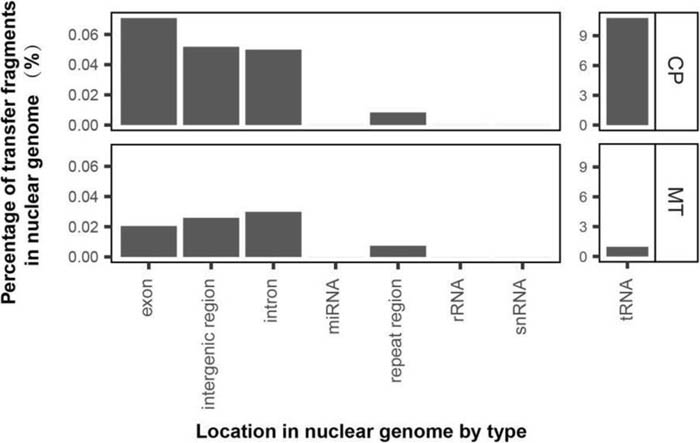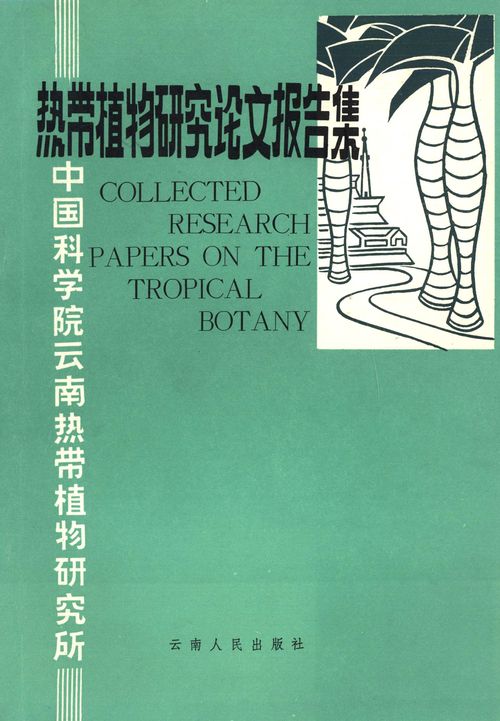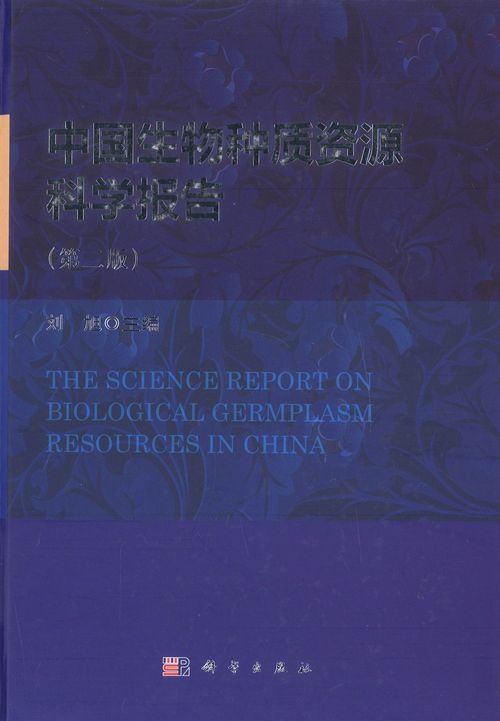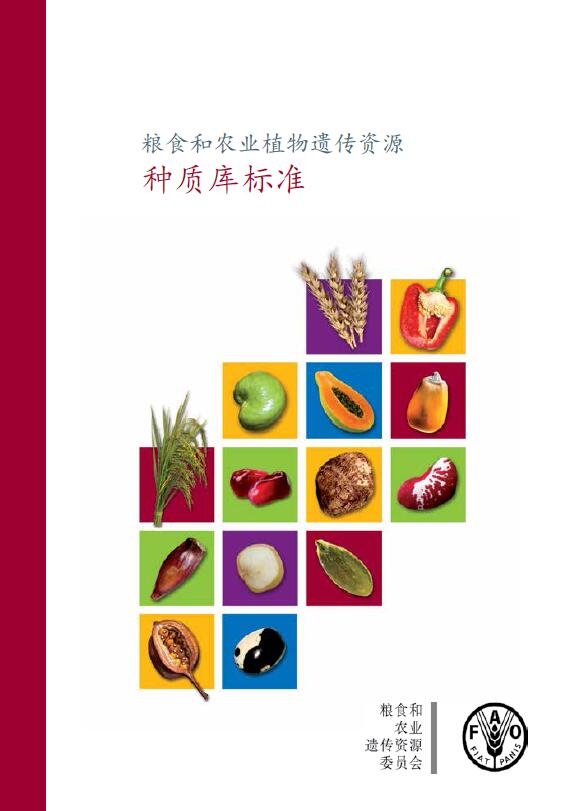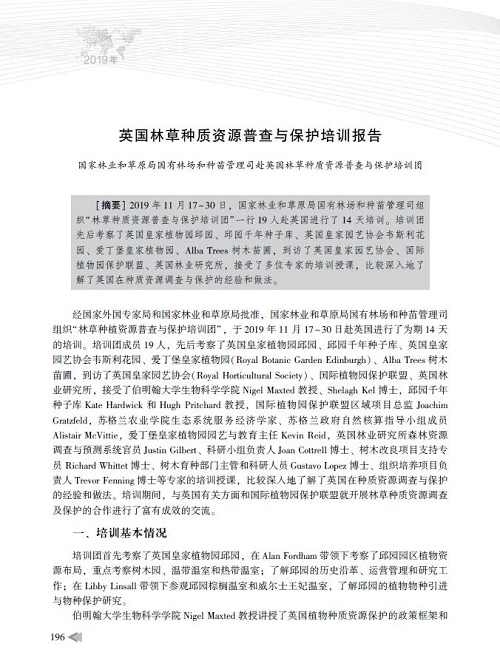
分子标记技术在樱属植物研究中的应用进展
编号
lyqk007233


中文标题
分子标记技术在樱属植物研究中的应用进展


作者单位
南京林业大学生物与环境学院, 南方现代林业协同创新中心, 亚热带森林生物多样性保护国家林业局重点实验室, 南京 210037


期刊名称
世界林业研究


年份
2018


卷号
31


期号
6


栏目编号
1


栏目名称
专题论述


中文摘要
蔷薇科樱属植物地理分布广泛,种类繁多,具有重要的生态、观赏、经济和文化价值。文中介绍了近年来国内外有关樱属分子标记技术的报道,着重综述分子遗传多样性、分子系统学和亲缘地理学3个方面的研究进展,总结研究现状并提出未来研究展望,以期为今后开展我国樱属种质资源分类鉴定、遗传育种、开发利用等研究提供思路与借鉴。


关键词
樱属
种质资源
分类界定
分子标记
系统进化
开发利用


基金项目
江苏省林业三新工程项目(LYSX[2015]17);江苏省研究生科研创新计划项目(KYCX17_0815);2017年南京林业大学优秀博士创新基金项目。


英文标题
Application of the Molecular Marker Technology to Cerasus Mill(Rosaceae)


作者英文名
Zhu Hong, Yi Xiangui, Zhu Shuxia, Wang Huachen, Wang Xianrong


单位英文名
College of Biology and Environment, Co-Innovation Center for Sustainable Forestry in Southern China, Key Laboratory of State Forestry Administration on Subtropical Forest Biodiversity Conservation, Nanjing Forestry University, Nanjing 210037, China


英文摘要
Cerasus Mill. is of important ecological, ornamental, economic and cultural values with a wide range of geographic distribution and a great variety of species. In this paper, we reviewed the research on the application of molecular marker technology to Cerasus in recent years, and described the progress in the research on molecular genetic diversity, molecular systematics and phylogeography. Then it summarized the current research status and prospected the future research fields. This study was expected to provide ideas and references for the future research on classification, genetic breeding, development and utilization of germplasm resources of Cerasus in China.


英文关键词
Cerasus Mill;germplasm resources;classification;molecular marker;phylogenetic evolution;development and utilization


起始页码
16.0


截止页码
24.0


投稿时间
2018/1/11


最后修改时间
2018/9/6


作者简介
朱弘(1990-),男,博士研究生,研究方向为国产樱属分类与生物地理学研究,E-mail:1107401987@qq.com。


通讯作者介绍
王贤荣(1966-),女,植物学教授,研究方向为国产樱属分类与资源利用,E-mail:wangxianrong66@njfu.edu.cn。


E-mail
王贤荣,wangxianrong66@njfu.edu.cn


分类号
S718.46;S718.49


DOI
10.13348/j.cnki.sjlyyj.2018.0045.y


参考文献
[1] 俞德浚,李朝銮.中国植物志:第38卷[M].北京:科学出版社,1986.
[2] 王贤荣.中国樱花品种图志[M].北京:科学出版社,2014:1-181.
[3] 李蒙,伊贤贵,王华辰,等.山樱花地理分布与水热环境因子的关系[J].南京林业大学学报(自然科学版),2014,38(增刊1):74-80.
[4] 朱弘,尤禄祥,李涌福,等.浙闽樱桃地理分布模拟及气候限制因子分析[J].热带亚热带植物学报,2017,25(4):315-322.
[5] 王贤荣.国产樱属分类学研究[D].南京:南京林业大学,1997.
[6] 黄晓姣,王小蓉,陈涛,等.中国樱桃遗传资源多样性研究进展[J].果树学报,2013,30(3):470-479.
[7] 方炎明,丁雨龙.植物生物学专题[M].北京:中国林业出版社,2016.
[8] 陈晓流,陈学森,束怀瑞,等.15个樱桃品种的RAPD分析[J].果树学报,2004,21(6):556-559.
[9] ZAMANI Z, SHAHIGHARAHLAR A, FATAHI R, et al.Genetic relatedness among some wild cherry (Prunus subgenus Cerasus) genotypes native to Iran assayed by morphological traits and random amplified polymorphic DNA analysis[J].Plant Systematics and Evolution, 2012, 298(2):499-509.
[10] TSUDA Y, KIMURA M, KATO S, et al.Genetic structure of Cerasus jamasakura, a Japanese flowering cherry, revealed by nuclear SSRs:implications for conservation[J].Journal of Plant Research, 2009, 122(4):367-375.
[11] KATO S, IWATA H, TSUMURA Y, et al.Genetic structure of island populations of Prunus lannesiana var.speciosa revealed by chloroplast DNA, AFLP and nuclear SSR loci analyses[J].Journal of Plant Research, 2011, 124(1):11-23.
[12] KATO S, MATSUMOTO A, YOSHIMURA K, et al.Clone identification in Japanese flowering cherry (Prunus subgenus Cerasus) cultivars using nuclear SSR markers[J].Breeding Science, 2012, 62(3):248-255.
[13] CANTINI C, IEZZONI A F, LAMBOY W F, et al.DNA fingerprinting of tetraploid cherry germplasm using simple sequence repeats[J].Journal of the American Society for Horticulturale, 2001, 126(2):205-209.
[14] PEDERSEN B H.DNA fingerprints of 51 sweet and sour Prunus accessions using simple sequence repeats[J].Journal of Horticultural Science and Biotechnolog, 2006, 81(1):118-124.
[15] ANTONIUS K, AALTONEN M, UOSUKAINEN M, et al.Genotypic and phenotypic diversity in Finnish cultivated sour cherry (Prunus cerasus L.)[J].Genetic Resources and Crop Evolution, 2012, 59(3):375-388.
[16] BARAC G, OGNJANOV V, OBREHT D, et al.Genotypic and phenotypic diversity of cherry species collected in Serbia[J].Plant Molecular Biology Reporter, 2013, 32(1):92-108.
[17] TURKOGLU Z, BILGENER S, ERCISLI S, et al.Simple sequence repeat-based assessment of genetic relationships among Prunus rootstocks[J].Genetics and Molecular Research, 2010, 9(4):2156-2165.
[18] ÖZ M H, VURGUN H, BAKIR M, et al.Molecular analysis of East Anatolian traditional plum and cherry accessions using SSR markers[J].Genetics and Molecular Research, 2013, 12(4):5310-5320.
[19] TURKOGLU Z, BILGENER S, ERCISLI S, et al.Simple sequence repeat (SSR) analysis for assessment of genetic variability in wild cherry germplasm[J].Journal of Applied Botany and Food Quality, 2012, 85(2):229-233.
[20] KHADIVI-KHUB A, ZAMANI Z, FATTAHI R, et al.Genetic variation in wild Prunus L.subgen.Cerasus germplasm from Iran characterized by nuclear and chloroplast SSR markers[J].Trees, 2014, 28(2):471-485.
[21] 吕月良.福建山樱花群体遗传多样性、繁育技术体系和育种策略研究[D].南京:南京林业大学,2006.
[22] 苏倩.福建山樱花种源遗传多样性研究[D].南京:南京林业大学,2007.
[23] 商韬,王贤荣,南程慧,等.基于SSR标记的迎春樱自然居群遗传多样性分析[J].甘肃农业大学学报,2013,48(6):104-109.
[24] 南程慧.迎春樱居群变异与繁殖生物学研究[D].南京:南京林业大学,2012.
[25] 陈娇,王小蓉,汤浩茹,等.基于SSR标记的四川野生中国樱桃遗传多样性和居群遗传结构分析[J].园艺学报,2013,40(2):333-340.
[26] 宛甜,蔡宇良,冯瑛,等.野生毛樱桃SSR遗传多样性和遗传结构分析[J].西北植物学报,2013,33(8):1544-1550.
[27] 陈洁.山樱花居群遗传多样性的SSR分析[D].南京:南京林业大学,2016.
[28] ZHANG J, CHEN T, WANG J, et al.Genetic diversity and population structure in cherry[Cerasus pseudocerasus (Lindl).G.Don] along Longmenshan Fault Zones in China with newly developed SSR markers[J].Scientia Horticulturae, 2016,212:11-19.
[29] 宗宇,王月,朱友银,等.基于中国樱桃转录组的SSR分子标记开发与鉴定[J].园艺学报,2016,43(8):1566-1576.
[30] 李春侨,周龙,陆彪,等.天山樱桃野生居群遗传多样性SSR分析[J].经济林研究,2017,35(3):44-49.
[31] DOWNEY S L, LEZZONI A F.Polymorphic DNA markers in black cherry (Prunus serotina) are identified using sequences from sweet cherry, peach, and sour cherry[J].Journal of the American Society for Horticultural, 2000, 125(1):76-80.
[32] BRETTIN T S, KARLE R, CROWE E L, et al.Chloroplast inheritance and DNA variation in sweet, sour, and ground cherry[J].Journal of Heredity, 2000, 91(1):75-79.
[33] TAVAUD M, ZANETTO A, SANTI F, et al.Structuration of genetic diversity in cultivated and wild cherry trees using AFLP markers[J].ACTA Horticulturae, 2001, 546:263-269.
[34] TAVAUD M, ZANETTO A, DAVID J L, et al.Genetic relationships between diploid and allotetraploid cherry species (Prunus avium, Prunus xgondouinii and Prunus cerasus)[J].Heredity, 2004, 93(6):631-638.
[35] LEE S, WEN J.A phylogenetic analysis of Prunus and the Amygdaloideae (Rosaceae) using ITS sequences of nuclear ribosomal DNA[J].American Journal of Botany, 2001, 88(1):150-160.
[36] 刘艳玲,徐立铭,程中平.基于ITS序列探讨核果类果树桃、李、杏、梅、樱的系统发育关系[J].园艺学报,2007,34(1):23-28.
[37] 王化坤,陶建敏,渠慎春,等.核果类果树ITS序列分子进化及系统发育关系研究[J].园艺学报,2010,37(3):363-374.
[38] ZHENG X Y, CAI D Y, POTTER D, et al.Phylogeny and evolutionary histories of Pyrus L.revealed by phylogenetic trees and networks based on data from multiple DNA sequences[J].Molecular Phylogenetics and Evolution, 2017, 80:54-65.
[39] SHAW J, SMALL R L.Addressing the hardest puzzle in American pomology:phylogeny of Prunus sect.Prunocerasus (Rosaceae) based on seven noncoding chloroplast DNA regions[J].American Journal of Botany, 2004, 91(6):985-996.
[40] BORTIRI E, OH S H, JIANG J-G, et al.Phylogeny and systematics of Prunus (Rosaceae) as determined by sequence analysis of ITS and the chloroplast trnL-trnF spacer DNA[J].Systematic Botany, 2001, 26(4):797-807.
[41] SHIMADA T, HAYAMA H, NISHIMURA K, et al.The genetic diversities of 4 species of subg.Lithocerasus (Prunus, Rosaceae) revealed by RAPD analysis[J].Euphytica, 2001, 117(1):85-90.
[42] BORTIRI E, OH S H, GAO F Y, et al.The phylogenetic utility of nucleotide sequences of sorbitol 6-phosphate dehydrogenase in Prunus (Rosaceae)[J].American Journal of Botany, 2002, 89(11):1697-1708.
[43] BORTIRI E, HEUVEL B V, POTTER D.Phylogenetic analysis of morphology in Prunus reveals extensive homoplasy[J].Plant Systematics and Evolution, 2006, 259(1):53-71.
[44] 石硕.蔷薇科李属樱亚属的系统学研究[D].北京:中国科学院研究生院,2013.
[45] SHI S, LI J L, SUN J H, et al.Phylogeny and classification of Prunus sensu lato (Rosaceae)[J].Journal of Integrative Plant Biology, 2013, 55(11):1069-1079.
[46] CHO M S, KIM C S, KIM S H, et al.Molecular and morphological data reveal hybrid origin of wild Prunus yedoensis (Rosaceae) from Jeju Island, Korea:implications for the origin of the flowering cherry[J].American Journal of Botany, 2014, 101(11):1976-1986.
[47] CHEN Z L, CHEN W J, CHEN H, et al.Prunus pananensis (Rosaceae), a new species from Pan'an of central Zhejiang, China[J].Plos One, 2013, 8(1):1-6.
[48] 叶立新,鲁益飞,王桦,等.凤阳山樱桃:浙江樱属(蔷薇科)一新种[J].杭州师范大学学报(自然科学版),2017,16(1):19-24.
[49] 曹东伟.李属樱亚属植物分子亲缘地理学研究[D].西安:西北大学,2006.
[50] 李苗苗.樱亚属植物分子亲缘地理及中国樱桃自然居群遗传多样性研究[D].西安:西北大学,2009.
[51] 陈涛,王小蓉,罗华,等.9个野生中国樱桃群体叶绿体DNA trnQ-rps16序列变异及其遗传结构分析[J].遗传,2012,34(11):1475-1483.
[52] CHEN T, WANG X R, TANG H R, et al.Genetic diversity and population structure of Chinese cherry revealed by chloroplast DNA trnQ-rps16 intergenic spacers variation[J].Genetic Resources and Crop Evolution, 2013, 60(6):1859-1871.
[53] CHEN T, CHEN Q, LUO Y, et al.Phylogeography of Chinese cherry (Prunus pseudocerasus Lindl.) inferred from chloroplast and nuclear DNA:insights into evolutionary patterns and demographic history[J].Plant Biology, 2015, 17(4):787-797.
[54] 赵庆杰,李海波,屈燕,等.基于SCAR标记的20个樱花品种的分子鉴别[J].南京林业大学学报(自然科学版),2016,40(5):34-40.
[55] ARANZANA M J, PINEDA A, COSSON P, et al.A set of simple-sequence repeat (SSR) markers covering the Prunus genome[J].Theoretical & Applied Genetics, 2003, 106(5):819-825.
[56] 葛学军.DNA条形码在植物系统发育区系学研究中的应用[J].生物多样性,2015,23(3):295-296.
[57] 裴男才,陈步峰.生物DNA条形码:十年发展历程、研究尺度和功能[J].生物多样性,2013,21(5):616-627.
[58] 刘志雄,王莹,吕小蒙,等.日本晚樱花器官特征基因ClAP1的克隆与表达分析[J].园艺学报,2010,37(4):649-654.
[59] XU X D, WEN J, WANG W, et al.The complete chloroplast genome of the threatened Prunus cerasoides, a rare winter blooming cherry in the Himalayan region[J].Conservation Genetics Resources, 2017.DOI:10.1007/s12686-017-0859-1.
[60] 张琪静.毛樱桃资源遗传多样性及与李属近缘种亲缘关系的研究[D].沈阳:沈阳农业大学,2007.
[61] FENG Y, LIU T, WANG X Y, et al.Characterization of the complete chloroplast genome of the Chinese cherry Prunus pseudocerasus (Rosaceae)[J].Conservation Genetics Resources, 2017,10(1):1-4.
[62] INNAN H, TERAUCHI R, MIYASHITA N T, et al.DNA fingerprinting study on the intraspecific variation and the origin of Prunus yedoensis (Someiyoshino)[J].Japanese Journal of Genetics, 1995, 70(2):185-196.
[63] IKETANI H, OHTA S, KAWAHARA T, et al.Analyses of clonal status in ‘Somei-yoshino’ and confirmation of genealogical record in other cultivars of Prunus×yedoensis by microsatellite markers[J].Breeding Science, 2007, 57(1):1-6.
[64] CHO M S, CHO C H, SU Y K, et al.Complete chloroplast genome of Prunus yedoensis Matsum.(Rosaceae), wild and endemic flowering cherry on Jeju Island, Korea[J].Mitochondrial DNA Part a DNA Mapping Sequencing and Analysis, 2015, 25(7):11-12.
[65] JORDANO P, GODOY J A.RAPD variation and population genetic structure in Prunus mahaleb (Rosaceae), an animal-dispersed tree[J].Molecular Ecology, 2000, 9(9):1293-1305.
[66] ZHAO L, JIANG X W, ZUO Y J, et al.Multiple events of allopolyploidy in the evolution of the racemose lineages in Prunus (Rosaceae) based on integrated evidence from nuclear and plastid data[J].Plos One, 2016, 11(6):1-21.
[67] CHIN S W, SHAW J, HABERLE R, et al.Diversification of almonds, peaches, plums and cherries-molecular systematics and biogeographic history of Prunus (Rosaceae)[J].Molecular Phylogenetics and Evolution, 2014, 76(1):34-48.
[68] 尤禄祥,陈志伟,王华辰,等.安徽黄山风景区微毛樱桃萌枝种群动态研究[J].植物资源与环境学报,2017,26(2):83-89.
[69] 李蒙,严邦祥,赵昌高,等.大仰山高山湿地山樱花种群数量结构特征[J].南京林业大学学报(自然科学版),2013,37(5):40-44.
[70] 王志高,张中信,汪文革,等.安徽岳西县鹞落坪国家级自然保护区森林群落结构的初步分析[J].植物生态学报,2016,40(6):615-619.
[71] MICHAEL T P, VANBUREM R.Progress, challenges and the future of crop genomes[J].Current Opinion in Plant Biology, 2015(24):71-81.
[72] ZHANG Q X, CHEN W B, SUN L D, et al.The genome of Prunus mume[J].Nature Communication, 2012, 3(4):1-8.
[73] SHIRASAWA K, ISUZUGAWA K, IKENAGA M, et al.The genome sequence of sweet cherry (Prunus avium) for use in genomics-assisted breeding[J].DNA Research, 2017, 24(5):1-10.


PDF全文
浏览全文


-
相关记录
更多
- 木通属植物资源及其开发利用研究进展 2022
- 珙桐系统分类及遗传变异 2022
- 云南确定9个草品种为林草良种 2022
- 土耳其油橄榄种质资源发展现状与启示 2021
- 广西笋用竹种质资源及其利用调查 2024
- 四川雷波竹类资源及其开发利用建议 2024
 打印
打印
